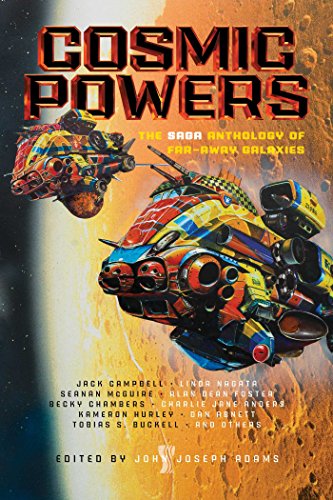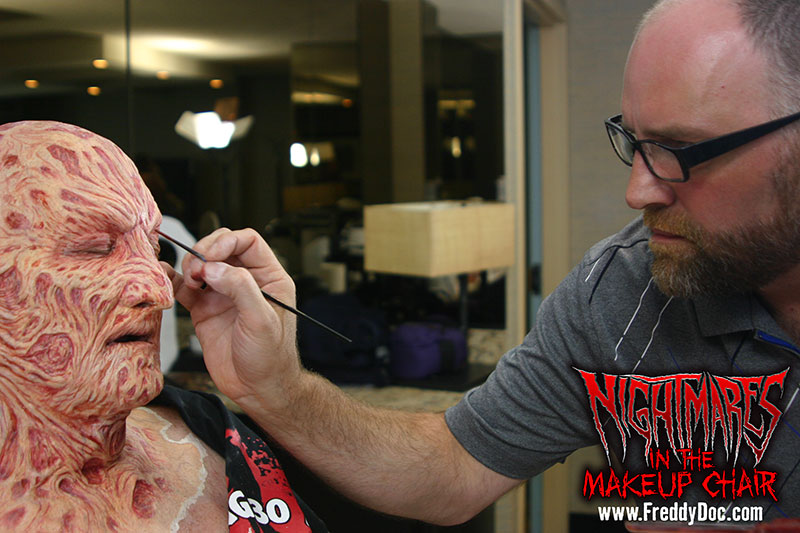(1) MORE CORE. This time James Davis Nicoll lists “Twenty Core Military Speculative Fiction Books Every True SF Fan Should Have On Their Shelves”.
Is there any overlap between your list and James’s?
(2) ENVELOPE PLEASE. Mark Lawrence’s Self-Published Fantasy Blog-Off has a winner — The Grey Bastards by Jonathan French. The results were based on scores given by the reviewers at 10 different blogs.
All in all The Grey Bastards is a runaway winner and I must commend it to your attention.
2nd placed Path of Flames by Phil Tucker was favourite with three blogs and I’ve read it and can see why!
3rd placed Paternus by Dyrk Ashton was favourite with one blog.
All of these books were someone’s choice for finalist and they all scored 7+ with two or more bloggers, so check them out. You never know what will hit a chord with you.
Huge thanks to all ten bloggers/teams for their very considerable efforts and to Katharine of Ventureadlaxre for stepping in to fill a gap. The bloggers are the stars of this show so be sure to keep checking them out now we’re done.
Our most generous scorer this year was Fantasy-Faction, taking the crown from Bibliotropic last year. The Elitist Book Reviews remain the harshest scorer, though they were slightly kinder this year.
(3) FILE 770 TODAY, PBS TOMORROW! Masterpiece Theatre is broadcasting King Charles III on May 14 with Tim Pigott-Smith as Charles. (Martin Morse Wooster reviewed the stage play here last month.)
(4) WORLD MAKER. Larry Correia provides a very interesting and expansive answer to a fan favorite question in “Ask Correia 18: World Building”.
Always Be Asking
Since I usually start with a basic plot idea, the first thing I do is think about what does my world need to have/allow for me to write this? Some are pretty obvious. Monster Hunter is our world but supernatural stuff exists in secret. Others ideas require something more complicated. For Son of the Black Sword I needed to figure out a world with brutal caste systems, where the low born are basically property.
Take those must haves, and then ask yourself if that’s how things have to work here, what else would change? Always be asking yourself how are those required things going to affect other things? This doesn’t just make your setting stronger, but it supplies you with tons of great new story ideas.
Besides creative questioning, his other subtopics are: The Rule of Cool, Using Cultural Analogs, Nuts and Bolts, You Need To Know Everything but the Reader Doesn’t, How Much is too Much? and Have Fun.
(5) SCIENCE FICTION IS NEVER ABOUT THE FUTURE. That’s why Trump’s election wrecked an author’s plans — ‘Sci-Fi Writer William Gibson Reimagines the World After the 2016 Election”.
But last fall, Mr. Gibson’s predictive abilities failed him. Like so many others, he never imagined that Donald J. Trump would prevail in the 2016 election. On Nov. 9, he woke up feeling as if he were living in an alternate reality. “It was a really weird and powerful sensation,” he said.
Most people who were stunned by the outcome managed to shake off the surreal feeling. But being a science fiction writer, Mr. Gibson, 69, decided to explore it.
The result is “Agency,” Mr. Gibson’s next novel, which Berkley will publish in January. The story unfolds in two timelines: San Francisco in 2017, in an alternate time track where Hillary Clinton won the election and Mr. Trump’s political ambitions were thwarted, and London in the 22nd century, after decades of cataclysmic events have killed 80 percent of humanity. In the present-day San Francisco setting, a shadowy start-up hires a young woman named Verity to test a new product: a “cross-platform personal avatar” that was developed by the military as a form of artificial intelligence. Meanwhile, characters in the distant future are interfering with the events unfolding in 2017, through technological time travel that allows them to send digital communications to the past….
… “Every imaginary future ever written is about the time it was written in,” he said. “People talk about science fiction’s predictive possibilities, but that’s a byproduct. It’s all really about now.”
(6) REASONS TO BELIEVE. The Vulture interviews the evangelist of American Gods – the author: “The Gospel According to Neil Gaiman”.
Pony sushi?
Pony. Because Iceland, what it actually has a lot of, is ponies. And then I walk into the downtown tourist office, now closed, and they had a fantastic tabletop diorama basically showing the voyages of Leif Erikson. You start out in Iceland, you nip over to Greenland, you go down the coast in Newfoundland and have a little thing where you build your huts, and so forth. I looked at it and I thought, Y’know, I wonder if they brought their gods with them. And then I thought, I wonder if they left their gods behind when they came home. And it was like, all of a sudden, all of the things that I’d been thinking about, all of the things that had been circling my head about immigration, about America, about the House on the Rock, and this weird American thing where … In other places in the world, they might look at a fantastic cliff and go, “Ah, here we are in touch with the numinous! We will build a temple or we will build a shrine!” In America, you get a replica of the second-largest block of cheese in the world circa 1963. And people still go to visit it! As if it were a shrine! I wanted to put that in. And it was all there. I wrote an email to my agent and my editor saying, “This is the book,” and ending with, “The working title is going to be American Gods, but I’m sure I’ll come up with something better.”
(7) WHATEVER IT IS, IT’S EXPENSIVE. Carl Slaughter asks, “OK, one of you science geeks explain to me, what exactly is laser based energy transmission?” — “LaserMotive raises $1.5 million to boost innovations in laser power transmission”.
LaserMotive, a stealthy pioneer in laser-based power transmission that’s based in Kent, Wash., has raised more than $1.5 million in an equity offering. LaserMotive focuses on laser applications for transmitting power. In 2009, the company won a $900,000 NASA prize in a competition for laser-powered robot climbers. In 2012, it kept a drone flying for 48 hours straight during a beamed-power demonstration for Lockheed Martin. And in 2013, it unveiled a commercial product to transmit electrical power over fiber-optic cables.
(8) LORD OF THE (SATURNIAN) RINGS. NPR and BBC on Cassini’s successful pass (“shields up!”) inside the rings:
“Cassini Spacecraft Re-Establishes Contact After ‘Dive’ Between Saturn And Its Rings”.
NASA said Cassini came within about 1,900 miles of Saturn’s cloud tops and about 200 miles from the innermost edge of Saturn’s rings. Project scientists believe ring particles in the gap are no bigger than smoke particles and were confident they would not pose a threat to the spacecraft.
“Cassini radio signal from Saturn picked up after dive”
The probe executed the daredevil manoeuvre on Wednesday – the first of 22 plunges planned over the next five months – while out of radio contact.
And the day before, a Google doodle showed Saturn “ready for its closeup”: “Cassini Spacecraft Dives Between Saturn and its Rings!”
By plunging into this fascinating frontier, Cassini will help scientists learn more about the origins, mass, and age of Saturn’s rings, as well as the mysteries of the gas giant’s interior. And of course there will be breathtaking additions to Cassini’s already stunning photo gallery. Cassini recently revealed some secrets of Saturn’s icy moon Enceladus — including conditions friendly to life! Who knows what marvels this hardy explorer will uncover in the final chapter of its mission?
(9) I HEARD THE NEWS TODAY. Two long-time sff editors and SFWAns have become editors of an Eastern Maryland publication — “Peter Heck and Jane Jewell Named Chestertown Spy Co-Managing Editors”.
The Community Newspaper Project, the parent nonprofit organization of the Chestertown Spy and Talbot Spy, has announced the appointment of Peter Heck and Jane Jewell as co-managing editors of the Chestertown Spy, effective immediately.
While Peter has been best known locally for his many years as a reporter for the Kent County News, he has also written over 100 book reviews for such publications as the Kirkus Review and Newsday, as well as spending two years as editor at Berkley Publications. A native of Chestertown, with degrees from Harvard and Johns Hopkins, Heck also has written ten novels, two of which were genre best sellers. He is also an accomplished musician, playing guitar and banjo.
Jane, Peter’s wife, also comes to the Spy with a distinguished background in writing, editing, and photography. Since moving to Chestertown, Jane worked at Washington College in the computer department, then as the executive director of the Science Fiction Writers of America. She also has contributed photos to the Kent County News. Jane currently serves on the board of the National Music Festival and has been active as a coach with the Character Counts! program in the Kent County Public Schools.
(10) BIG DATA IS WATCHING. Tracking whether a driver was texting: “‘Textalyzer’ Aims To Curb Distracted Driving, But What About Privacy?”
If you’re one of the many who text, read email or view Facebook on your phone while driving, be warned: Police in your community may soon have a tool for catching you red-handed.
The new “textalyzer” technology is modeled after the Breathalyzer, and would determine if you had been using your phone illegally on the road.
Lawmakers in New York and a handful of other cities and states are considering allowing police to use the device to crack into phones because, they say, too many people get away with texting and driving and causing crashes.
(11) A FACE IN THE CROWD. Using face-recognition software at a soccer match: “Police to use facial recognition at Champions League final”.
Police in Wales plan to use facial recognition on fans during the Champions League final in Cardiff on 3 June, according to a government contract posted online.
Faces will be scanned at the Principality Stadium and Cardiff’s central railway station.
They can then be matched against 500,000 “custody images” stored by local police forces.
South Wales Police confirmed the pilot and said it was a “unique opportunity”.
Chip Hitchcock sent this comment with the link: “It will be interesting to see how many false positives they fess up to and how many known troublemakers they miss; I have the impression that FR software is not ready for prime time.”
(12) ANOTHER COMMENT ON ODYSSEY CON. Bill Bodden also dropped off Odyssey Con programming, as he notes in “Timing Is Everything”.
Monica’s resignation as a guest went down on Monday. By the end of the week, all three Guests of Honor had withdrawn from the convention, and the harasser was no longer part of the convention committee. I myself tendered my withdrawal as attendee and panelist on Tuesday April 11, when it became clear that vocal members and friends of the Odyssey Con committee had taken it upon themselves, in a campaign of damage control, to try to spin the discussion to make Monica look bad. To my mind, Monica pulled out from an untenable situation, and while I’m deeply sorry it had to happen at all, I absolutely support her decision. I apologize in the unlikely event that anyone was coming to Odyssey Con specifically to see me.
Just the week before he’d gone 15 rounds with misogynistic trolls in “What the Hell Is Wrong With Gamers?”
Green Ronin Publishing recently put out an open call for female game designers for a specific project. I used to be one of the Ronin, and I was proud to see them doing something that everyone should have been doing years ago: forcing the issue to give women more of a chance to be game designers. Here’s the LINK so you can read it.
The outcry was immediate and vitriolic. I refuse to link to any of the trolls involved, but cries of discrimination against white men were on all the major gaming discussion boards, some gamers even suggesting that Green Ronin was destroying their company, alienating their fan base by committing such a heinous act against men….
Maybe those men who say they don’t behave that way really don’t, but I’ll bet they also don’t stand up — or even notice it — when other men do. Know how I know that? Because I had an experience over the last few years that proved to me how blind I was to this sort of thing. An individual was labeled harasser by a number of women, and I had a difficult time believing it was true because this person was a friend of mine in one of the circles with which I sometime engage, and I’d never seen him behaving that way. However, now being aware that it was an issue, the next time I saw him interacting with others, the harassment of women was clear, and obvious. It opened my eyes.
(13) FLYING FINISH. With the official Clarke Award shortlist coming out next week, the Shadow Clarke jury is pouring on the speed. Perhaps that explains their reluctance to break for a new paragraph?
Just over a third of the way through Christopher Priest’s The Gradual, the modernist composer, Alessandro Sussken, is told by Generalissima Flauuran, the dictator of the totalitarian Glaund Republic, that she wants him to compose a full orchestral piece celebrating the tenth anniversary of the Republic but ‘we do not want irony, subversion, subtlety, cryptic statements, cross references, allusions, knowing asides, quotations, hidden meanings.’ Instead, the stipulated requirements include a minimum of four movements, three major instrumental soloists, four operatic soloists, a mixed chorus of over three hundred voices, a sequence of peasant celebration, a triumphal march and ‘cannon effects in the climax’. It’s difficult not to see this – especially in the context of shadow Clarke discussions concerning the relationship between SF and the ambiguity of the modern condition – as a commentary on the ironies of being a writer torn between desiring the possibilities that the genre opens up for interrogating the limits of consensus reality while hating the conformist demand to meet certain expectations that it also embodies. It is as though Gollancz had said to Priest, ‘We’ll leave you alone to write your weird stories of alienation and separation, as long as you knock out a mass-market, three-act space opera with a world-weary hero, feisty heroine and cynical robot as the three main characters, and include alien sex, a heist sequence and a climactic space battle.’ Would Priest indignantly decline or take the money and run as Sussken does? The answer, based on the evidence of The Gradual, is not as obvious as one might think.
Time travel TV shows can be broadly divided into two categories based on whether they’re about conserving history or changing it. On the one hand, Legends of Tomorrow or Timeless are about characters from our present preserving the status quo of our past, no matter how many historical atrocities must be committed to make that happen. On the other hand, 12 Monkeys or Travelers are (generally better) shows about characters from our future attempting to change the status quo of their past: our present is the error they’re setting out to change. The first category is big on costumes and cliché historical settings. The second is usually about future dystopias that must be prevented by taking action in our present: depending on budget, we may see more or less of the future dystopia itself, which features its own set of clichés….
All historical fiction is alternate historical fiction, to a greater or lesser extent.
The setting is always other than it was; necessarily so, because we can only access the past through the imperfect lens of the present. Our 21st century way of knowing the world may be intimately connected to the experiences of human beings one hundred, five hundred, even two thousand years ago, but it is also paradigmatically alien. When we imagine, interpret and co-opt those experiences to tell stories we do so in the spirit of conjecture. Which is not to say that historical fiction cannot strive for factual veracity, only that it can never be completely achieved. Speculation creeps in – in some cases more than others – and because of that historical fiction shares some essential qualities with science fiction: the will to imagine otherwise; the displacement of human experience in time; and the estrangement of the reader from the contemporary familiar. The great historical fiction writers of the last century – Mary Renault, Dorothy Dunnett, Patrick O’Brian, Hilary Mantel – wrote (and write, in the last case, we hope and pray) with the ferocious enquiry that I also associate with great SF. For which reason I have few qualms about the eligibility of Colson Whitehead’s The Underground Railroad – a book that harvests and reaps influences from both genres – for a science fiction award. I would have equally few about its eligibility for a historical fiction prize….
Before I get on with the review – feel free to skip ahead to the subheading at any point in what follows – I should note that my participation in this Clarke Award shadow jury has not progressed in the manner I anticipated. First an industry-standard biannual workplace restructuring took an unexpected detour into poorly-executed dystopian satire during March and, second, an unexpected family bereavement has wiped out the first half of April. I had anticipated being pretty much through reviewing my six titles by this stage and to be on the verge of subjecting unwitting readers to my own idiosyncratic analysis considering the wider issues of contemporary SF and the state of the novel today. However, as I still have four novels to write about, I have no choice but to try and weave any hot takes I might have gathered from the process in with the narrative analysis and close reading of the text in question. The time-honoured way of doing this for academics is to riff off the work of other academics and, therefore, I am going to consider a couple of points from fellow jurors.
(14) EMOTION PICTURES. In her latest column for Amazing Stories, Petréa Mitchell reviews installments of eight animé series: “Anime roundup 4/27/2017: The Strong Survive”.
The Eccentric Family 2 #2-3 – The magician Temmaya was a friend of the people who ate Yasabur?’s father, until he fell out of favor with Benten and/or her colleague Jur?jin. He’s also stolen something that belongs to the Nidaime. And to complicate things further, Benten’s back and doesn’t seem to be getting along with the Nidaime either. The old bit of tanuki wisdom about not getting involved in the affairs of tengu is sounding very wise about now; although none of them is strictly a tengu, three humans with serious magical powers having an argument looks bad enough for the supernatural society of Kyoto. Unfortunately, Yasabur? is already too entangled to extricate himself….
Everything about this show is still top-notch. Kyoto feels like a living, complicated city, practically a character itself among the complicated individuals populating it, from Temmaya to Yasabur?’s grandmother the venerated sage. This is going to be a real treat.
(15) STREET ARTISTS. It’s a paradox — “In Hollywood, superheroes and villains delight crowds – and sleep on the streets”. The Guardian tells why.
In a parking lot off Hollywood Boulevard, Christopher Dennis recently changed into a Superman outfit, complete with a muscle suit and calf-high red boots. He headed out through the crowds, a habit he was resuming after a forced absence.
“You look like you’ve come out of the movie screen, man!” said a parking attendant.
“Man, you’re back!” said a street vendor selling imitation flowers.
Many people who frequent the boulevard – not least the other superhero impersonators, who pose for tourists for tips – know the reason Dennis was gone. For about seven months he was homeless, and lived in a tent and under tarps in different places in the city.
Among the characters showboating in front of the Chinese Theater and parading in their regalia along the Walk of Fame, his situation is not unprecedented. There is a Darth Vader who has spent nights sleeping on the sidewalk with a costume in a backpack, and a Joker whose survival strategy sometimes involved trying to stay awake when it was dark out….
(16) E-TICKET RIDE. A little bonus for the tourists on Tuesday – not an imitator, but the real guy — “Johnny Depp Appears as Captain Jack Sparrow on Pirates of the Caribbean Ride in Disneyland”
It’s not the rum, Disneyland visitors — that was Johnny Depp in the flesh!
Riders on the Pirates of the Caribbean attraction at the Disneyland Resort in Anaheim, California, got a special surprise on Wednesday night: Depp transformed back into Captain Jack Sparrow and greeted those who visited the inspiration behind the film franchise.
https://twitter.com/ItsMandizzle/status/857443816827043840
[Thanks to Cat Eldridge, James Davis Nicoll, Mark-kitteh, JJ, Chip Hitchcock, Michael J. Walsh, Carl Slaughter, and John King Tarpinian for some of these stories. Title credit goes to File 770 contributing editor of the day Ken Richards.]






